This paleo dim sum recipe uses a paleo pasta filled with flavorful ginger and pork and is steamed to perfection to make these amazing Asian potstickers.
The other day I was having cravings for pasta or something similar, but I didn’t want to have the usual rice noodles that I occasionally eat when the rest of my family eats homemade wheat pasta. Ever since going gluten free and mostly grain free, I don’t have that many cravings for bread or pasta, but every once in a while it’s bound to happen.
I was determined that I wanted to make a sort of grain free pasta, and started experimenting with different mixes of grain free flours to try to get the right consistency for making pasta. I ended up coming up with a combination that made a tasty pasta, but the mixture was a bit too delicate for pulling though the pasta maker as I have always done with traditional wheat flour.
This pasta worked better with a rolling pin and cutting by hand. The dough itself is quite delicate, but the pasta, once boiled, actually has a pretty solid consistency resembling wheat pasta al dente; the flavor isn’t that different either!
As I was rolling out the flour and looking through my fridge, trying to decide what I wanted to make myself to eat, I though about using the pasta dough to make something I’ve wanted to try making for quite some time. I decided to try to make myself a paleo dim sum recipe.
To be honest, I wasn’t quite sure what I was getting myself into, or if it would work out, but I kept going anyway. I’m so glad I did because I can truly say that I enjoyed this recipe.
You can probably tell that, despite being an American girl living in Spain, I like to try making and paleo-fying a lot of Asian recipes. I don’t know why, but I guess it’s because I’m attracted to the exotic flavors like ginger, soy sauce, litchis and matcha.
With that introduction, let me share with you my paleo dim sum recipe.
I hope you enjoy it as much as I did. (Even my husband liked this one.) 🙂
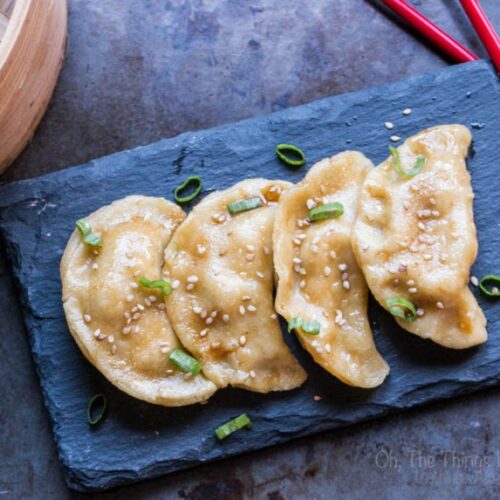
Ingredients
- 1 1/4 c. tapioca flour
- 3/4 c. almond flour
- 2 egg
- 1/2 tsp. salt
- 400 g ground pork
- 3 cloves garlic minced
- 1 inch ginger root grated
- freshly ground black pepper
- salt to taste
Instructions
- Mix together the almond flour, tapioca flour, and eggs. It’s easiest if you use your food processor, and you should end up with a grainy mix that holds together well when compacted.
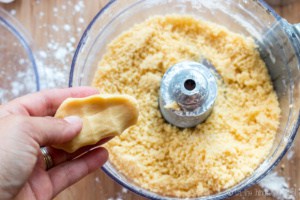
- Make a ball of the mixture and knead it as best you can. If needed, add a little bit of hot water. I like to add hot water because it seems to help make the dough stick together better.
- Let the dough set while you begin to make the filling. Brown the ground pork in a frying pan over high heat, adding in the minced garlic cloves and salt and pepper to taste once browned.
- Grate your ginger root and it to your filling mixture. I like to add a lot of ginger to give it a favor punch, but you can add as much as you like.
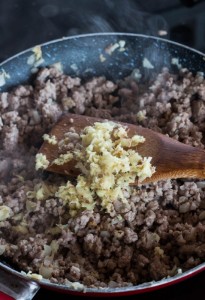
- Roll out your dough with a rolling pin. If you’re having issues with the dough sticking, I’ve found it easiest to roll the dough out between two layers of parchment or wax paper. try to get a very thin layer of the pasta dough.
- Use a circular cookie cutter (or the edges of a glass or whatever you have available) to cut out circles of pasta dough.
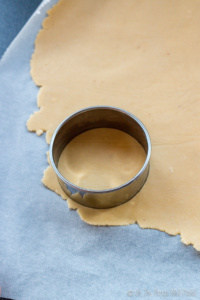
- Brush the inside of the dough with a little water and add a spoonful of the filling mix to the center of the dough. (How much you use will depend upon the size of your circles.)
- Fold the dough circles in half and pinch the edges of the dough together with your fingers to seal the potstickers closed.
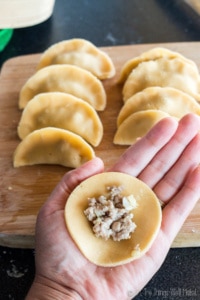
- Once you have finished making your dim sum, you are ready to steam them. I used a bamboo steamer to steam mine in a wok over some simmering water. To keep them from sticking to your steamer of choice, line it with cabbage leaves or parchment paper or something similar. (There is a reason these are called potstickers.)
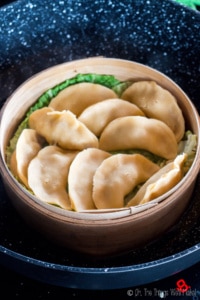
- Keep steaming until the pasta changes texture and looks cooked (Or you can taste one to check for doneness.) It took me about 10-15 minutes to steam each batch.
- Remove from the heat, and serve with a dipping sauce of your choice. I mixed together a little soy sauce, sesame oil and Asian plum vinegar, but to make it totally paleo you can substitute out the soy sauce for coconut amino or something else.
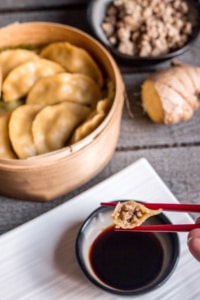
 Español
Español


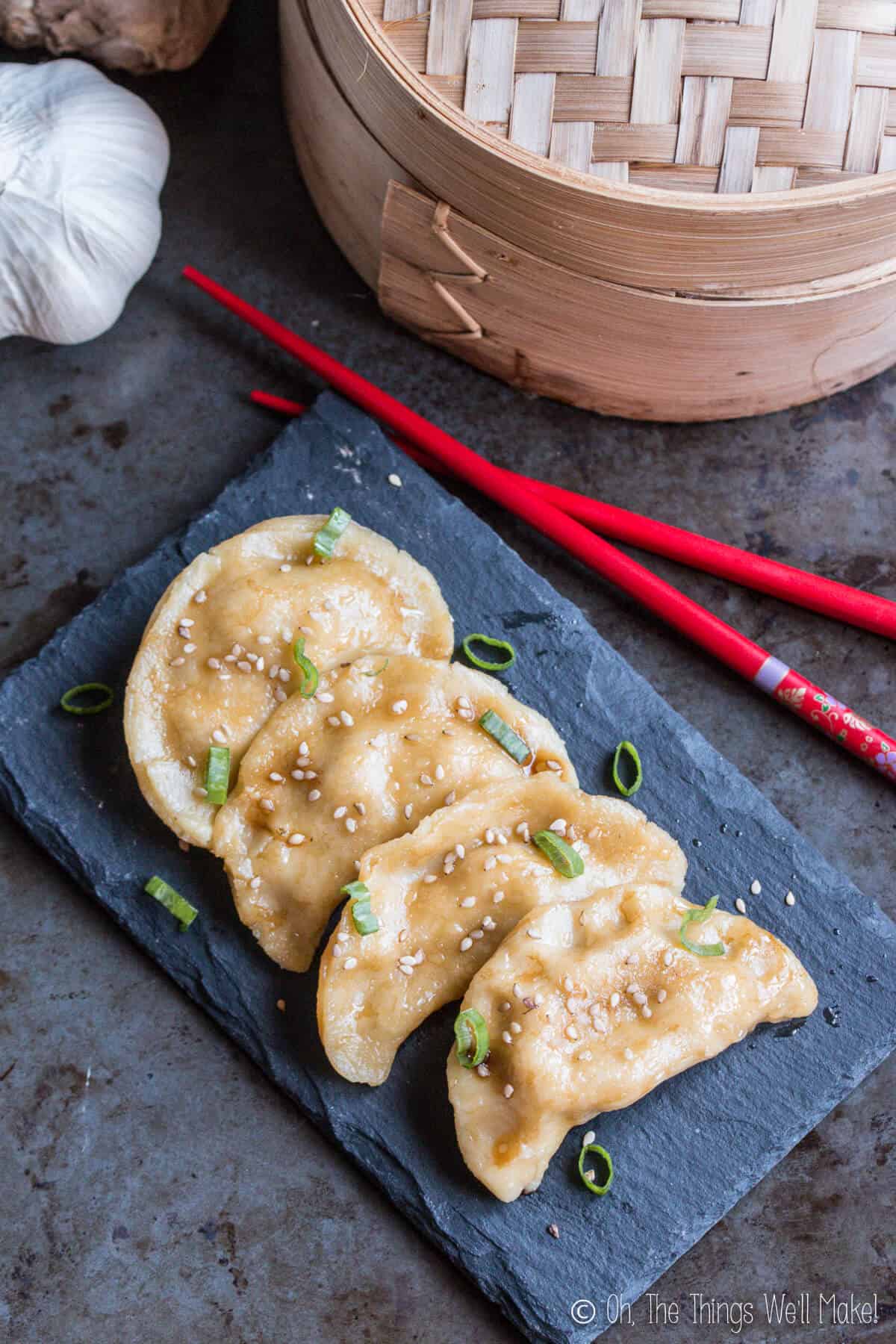
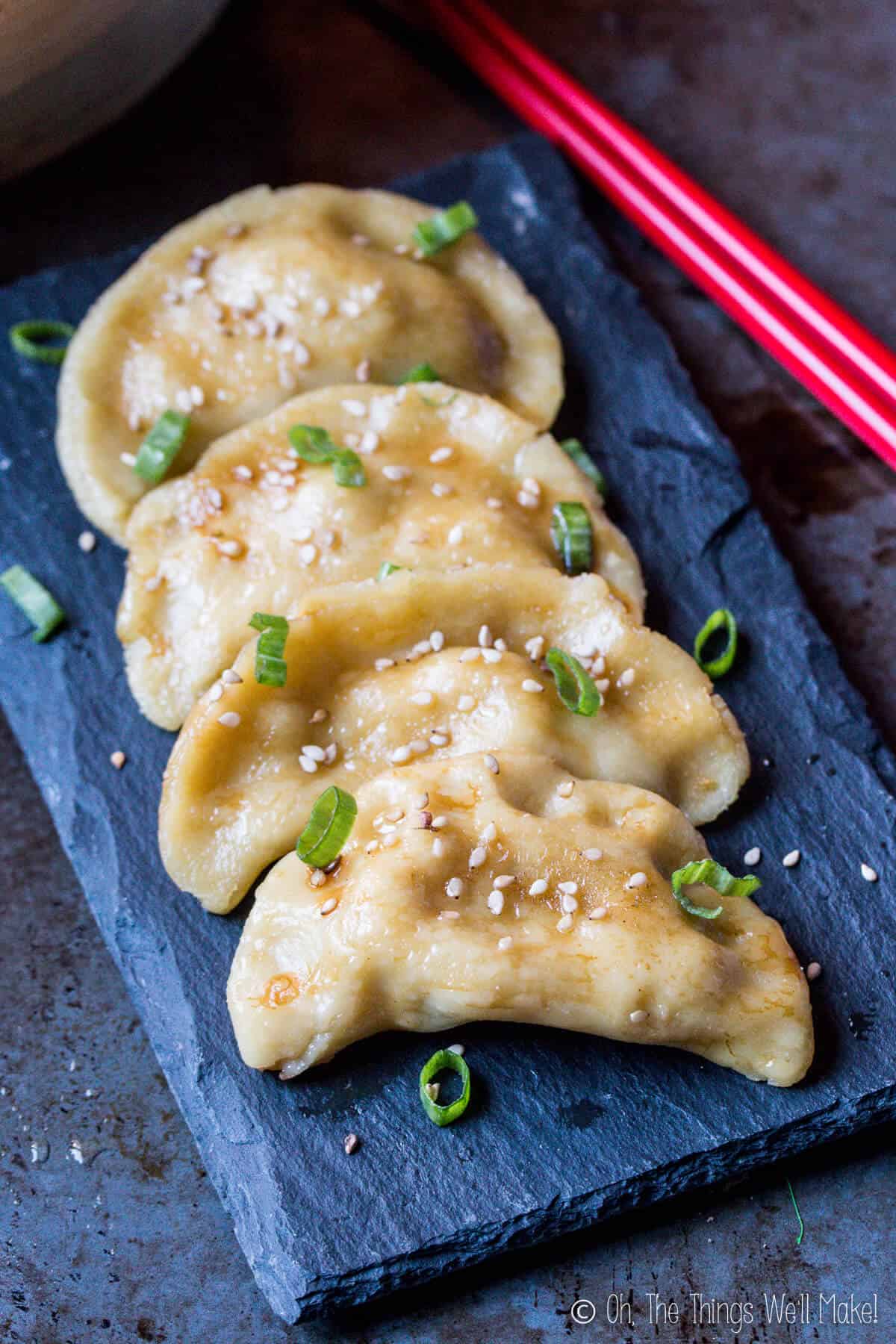
 Homemade Paleo Pita Recipe
Homemade Paleo Pita Recipe
Chris
Hi
I have both tapioca starch and cassava flour. Which is best to use please?
Thanks in advance!
Chris
Tracy Ariza
Hi Chris,
I’ve actually been working on updating this recipe lately, because I wanted to add video, and have been doing a lot of new trials with it. I use tapioca starch, like the common ones that are normally found at Asian and Latin American supermarkets. I haven’t been able to find a cassava flour here in Spain, but my guess is that either would work just fine.
I think when I originally wrote this recipe, we were just getting small eggs from our hens, so I used 2 for the amount of flour in the recipe, but now I’m finding that with 2 larger eggs, you’ll end up with a sticky dough, and may need to add more of the flours to get it to come together.
I’m also finding that it works out much better to add the raw meat to the pot stickers before steaming. You can use a lot more filling, and they taste even better. The only thing that has kept me from updating yet, is I’m trying to work out the exact amount of flour to eggs that works out best for me. Obviously it still may need adjusting, according to the size eggs you buy and even the humidity where you live, but I’d like to get it closer to what would work out well for most people without having to add anything.
I hope that helps.
Michael Weiss
Hello Tracy, I live near Barcelona and have been able to find cassava flour at a wonderful store in Granollers called “la Perla” (c/ Goya 5). They import it, package it and distribute it themselves under the “King Africa” brand. I don’t know if you are in this area, but if so definitely check out the store. I’ve been able to find some great cassave/yuca products for our paleo/anti-inflammatory diet.
Tracy Ariza
Hi Michael,
I’m in Denia, right smack between Valencia and Alicante.
Thanks for the heads up, though. I’ll look it up.
I actually made cassava flour a couple of weeks ago. I’ll be posting it on the blog soon- I’ve been wanting to try it out in various recipes first, though. 😉
Olika
These potstickers look so good! I look forward to trying them later this week. The one thing I was wondering about was how long does it it take to make them in total? Sorry if I just didn’t see the timing…
Tracy Ariza
Hello,
Thanks!
To be honest, I never time myself. I honestly should so that I can give a better idea in the timing of my recipes. The problem with this sort of recipe is that it mostly depends on how good you are at making dumplings. 😉
It’s very quick to mix up the dough, and it’s also a quick process to cook them. I used cooked meat inside so as not to have to worry about if everything gets cooked through properly, so it’s a matter of making sure the wrapper is cooked to your liking.
The step that takes the longest is wrapping the dumplings. My first ones were pretty slow, but I got a lot quicker as I went along.
I may have to make these again soon so I can make a video of the process. They really are very tasty! 🙂
Livia
How long does it take in total to make this? Sorry if I didn’t see it. They look so good! Can’t wait to try them this week!!
Gan Lee
These are potstickers, dim sum isn’t one singular food. Dim sum is the term we use for certain types of Cantonese brunch foods. That said, when I reintroduce eggs I’d love to try this recipe.
Tracy Ariza
Ha! Thanks for the information!
I remember debating what to call them when I wrote the recipe, and ended up choosing “dim sum” because I realized that a lot of people use the terms interchangeably and were searching for “dim sum” recipes on Google without a lot of recipes to choose from. Perhaps I should add both names to the title, and give an explanation in the beginning to clear things up.
I really love this recipe. I have to admit that it’s been awhile since I’ve made it, though. I’ve been cold and making a lot of soup based meals lately, but now that I’ve seen these again, I may have to add it to my list of things to make next week. 🙂
Dano B
Is there a technical reason you browned the pork first or a preference? When making regular glutenfied ones, the pork is usually raw going in, but cook throughout during steaming. Wondering if you chose to do this or is this dough doesn’t allow the contents to cook in the time allotted via steaming?
Tracy Ariza
Hi Dano,
For me it was just a personal preference. Especially when working with new doughs, I like to simplify things as much as possible and keep as many potential problems as I can out of the recipe so that the recipes are most likely to work out the same way for everybody. I can imagine writing up the recipe with raw pork, and then everybody complaining that they ended up with uncooked dim sum. 😉
I personally haven’t tried using raw pork. I ended up making a big batch of the (cooked) filling, and used it for other things too. We like to fill tortillas with ground beef or pork and veggies quite often or inside a quesadilla. For me it’s just easier to cook it all at once, and then use some of the cooked meat in the dim sum. That way I don’t have to worry about if it was cooked long enough or not.
I don’t imagine that there would be any reason you would have to cook it first, but since I haven’t personally tried it raw yet, I can’t promise you how well it will cook within this dough.
If you do try it, I’d love to hear how it works out. Maybe next time I could leave just a bit of the filling mixture raw to try to make a few that way to see how it goes.
I hope that helps you. Merry Christmas!
Veronica
Thank you so much for the recipe! Just made them tonight they were delicious ? Only thing I need to change is to separate them more. They definitely stick together and don’t come apart easily. Mine broke apart and only few survived. I’m confident next time I’ll have full pot stickers ?
Tracy Ariza
Hi Veronica,
I’m so glad you liked them!
That’s a great tip. Perhaps I should update the recipe to warn people. I separated mine, so I didn’t have any issues, but I can definitely see how that could be a problem! 🙂
Alia
How many carbs are these?
Charles W.
Do you think that these could be cooked like potstickers? I like the crunch that postickers have! But these look delicious either way.
Tracy Ariza
Hi Charles,
Thanks!
Do you mean the type that are fried in oil?
I haven’t personally tried it, but I imagine that they would fry up nicely. I do breading for frying using a mixture of almond flour and tapioca starch and it fries up nicely and even gets crispy. I actually like the way it turns out better than wheat flour breading.
Next time I’ll have to save a few to test it out.
If you try it, I’d love to hear how it goes!
Cindy
Way too much tapioca for me. Can’t use that much. Is there anything I can sub for that?
Tracy Ariza
Hi Cindy,
I’m not sure that there is anything without gluten other than tapioca flour that has an elastic enough texture to hold up to shaping for a homemade paleo pasta like dough. Perhaps part of the tapioca flour could be substituted with a rice flour. Some rice flours like the glutinous rice flours can achieve a similar type texture, so they may be a possible alternative to the tapioca flour, but the final dim sum wouldn’t be considered paleo if that’s important to you. (And I-m not even sure how well it would work.)
Jody
have you tried making ravioli with this pasta recipe? I wondering if it will stay closed if boiled.
Tracy Ariza
Hi Jody,
Actually I haven’t tried it yet, but I’ve been meaning to try it because I want to remake my chocolate ravioli recipe with a grain free pasta.
If you try it, I’d love to hear how it goes. If I try it first, I’ll try to remember to let you know. 😉